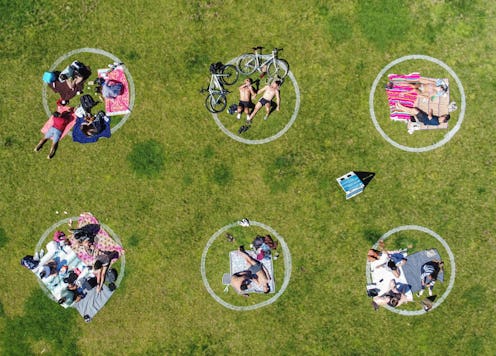Life
A Doctor Explains How To Be Safe During A Socially Distant Picnic

As the weather gets warmer and many states continue to reopen, spending time outdoors has never been so appealing. Understandably so — we’ve all been stuck inside for weeks, many of us months. However, enjoying the summer weather will require finding things that are safe to do outside amidst during the coronavirus pandemic. So, don’t pack up your picnic basket just yet.
Beaches, pools, campgrounds, and parks have reopened in many states. But you shouldn’t expect to enjoy these public spaces as you did before March. Yosemite National Park has begun allowing guests after being closed for two months. However, all commercial services within the park will be closed, as Mercury News reports. Guests will need to bring all their own food, beverages, supplies as well as a full tank of gas. Other national parks across the country have begun the process of reopening, though some are still keeping areas like campgrounds off-limits to help prevent potential virus exposure.
If you’re wondering whether it’s safe to have a picnic outside, the answer is yes but with some important caveats. Like with nearly every other aspect of our daily lives, the way we enjoy the outdoors will need to adapt as we work to contain the spread of COVID-19.
Continue Practice Social Distancing And Limit The Time Spent Around People
The Center for Disease Control and Prevention (CDC) still recommends people practice social distancing and wear a mask when social distancing isn’t possible. The basic guidelines for proper social distancing are:
- Stay at least 6 feet away from other people
- Do not gather in groups
- Stay out of crowded places and avoid mass gatherings
“The thing is, even if you’re outside, sitting with someone for 10 minutes or longer, that's still a close contact,” Dr. Jessie Abbate, an infectious disease biologist from Virginia and research associate at the French National Institute for Development, tells Bustle. “The longer you sit together, even distanced, the more viral particles are able to make it past all the obstacles to infect you.”
Keep Your Groups Small And Consistent
Dr. Abbate recommends keeping one or two consistent groups of people with whom you plan on gathering. “Just remember,” she says, “when you have lunch with one friend, you're also kinda having lunch with any virus from everyone they've seen in the past two weeks.”
Gathering outside is safer the gathering inside, Dr. Abbate notes. However, the margin is very slight. Initial research suggests that the risk of coronavirus is the transmission is lower outdoors but that doesn’t eliminate the risk of transmission entirely. “This virus is not contained,” Dr. Abbate states, “it's not slowing down on its own. The fewer risky things you do, and your neighbors do, the longer you can push off a second wave of stay-at-home measures.”
Stay Home If You’re Showing Any Symptoms
The CDC’s guidelines for parks and recreational facilities lists staying home if you aren’t feeling well as one of the key things to keep in mind when gathering outdoors. Some of those symptoms include fever, coughing, shortness of breath, fatigue, or recent loss of taste or smell. Additionally, you should continue covering your coughs and sneezes, washing your hands, and avoiding touching your face with unwashed hands.
Abiding by these guidelines may seem strange or inconvenient, but you know what's worse than being inconvenienced? Having and spreading coronavirus. Enjoy the outdoors, go on a picnic with a limited group of friends, but remember to stay safe.
Expert:
Dr. Jessie Abbate, an infectious disease biologist from Virginia and research associate at the French National Institute for Development.
This article was originally published on